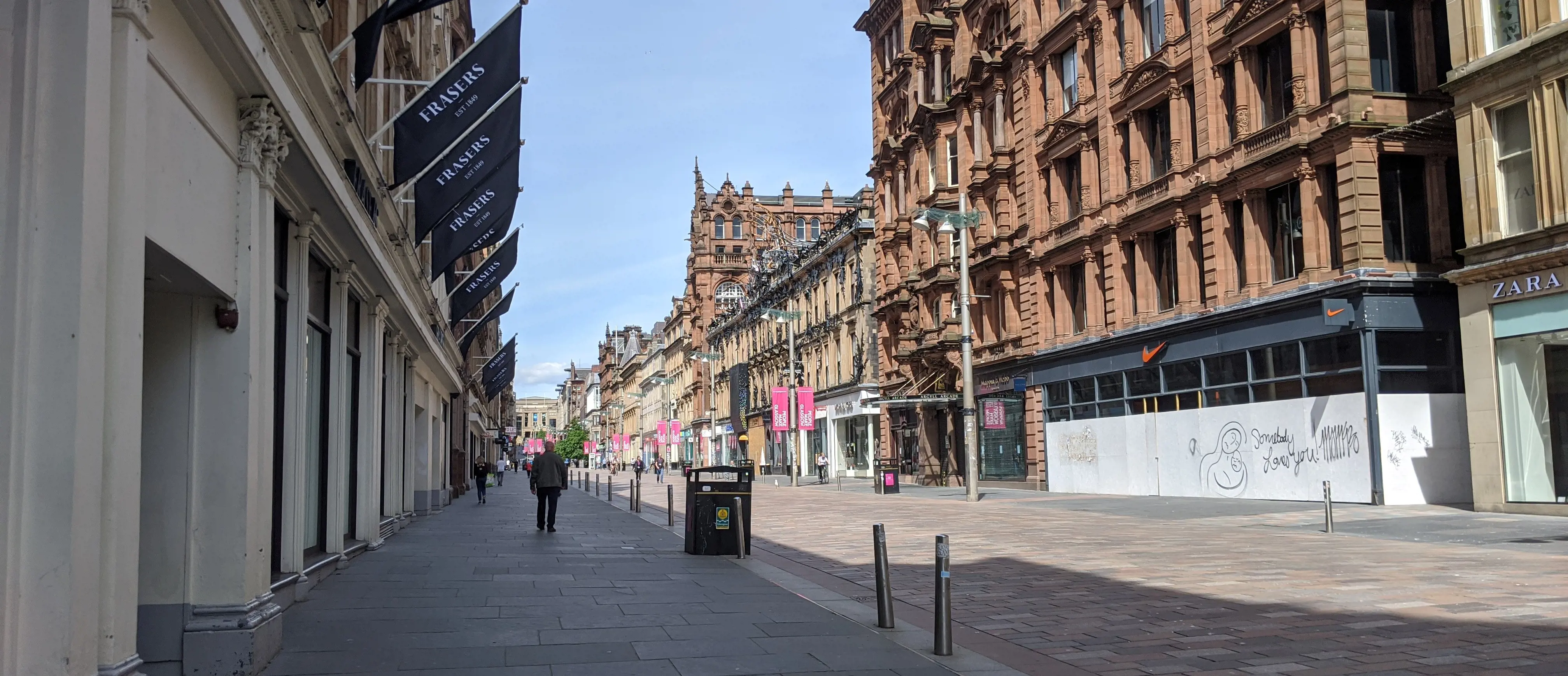It has been another tumultuous few weeks for our town and city centres. As the pandemic and UK-wide lockdowns continue, a raft of the nation’s most famous retailers are soon to disappear from high streets across the country. Neither Debenhams nor Arcadia’s high profile Topshop or Burton brands have been able to secure buyers for their existing retail units, and those stores will now add to the ever-increasing level of vacancy on the high street. These stores alone span 562 retail units totalling 1,389,137 m
2 of floor space, or the equivalent of almost 200 football pitches
[1]. Symbolically for Scotland, the iconic Jenners department store in Edinburgh is to close after 183 years.
Amid all of this bad news comes the publication of ‘
A New Future for Scotland’s Town Centres’ by the Town Centre Action Plan Review Group, Chaired by Professor Leigh Sparks. The report is a follow-up to the Scottish Government’s 2013 Town Centre Action Plan, which itself emphasised the role of town centres and the need to prioritise and support them. It promoted the Town Centre First principle, and explored themes including town centre living, accessible public services, proactive planning, digital towns, enterprising communities and vibrant local economies.
For a period during the years that followed, there were encouraging signs. Lichfields undertook our own research (
Supporting Scotland’s Growth: What Next for Town Centre and Retail Development?) in 2016 which suggested that, whilst the sector had been subject to considerable change, it continued to offer significant growth potential. Indeed, at that time, our research suggested that cities such as Stirling were expected to generate growth of over 20% in terms of retail and leisure GVA. We also found that retail and leisure jobs accounted for over 25% of total jobs across Scotland and contributed to around £88 billion of consumer spending.
The sector therefore continues to be pivotal to the future social and economic wellbeing of both Scotland and the wider UK. However, as in the rest of the developed world, the COVID-19 pandemic has been a ‘game changer’ for our town centres. With the growth in online shopping over the last decade or so, most centres had already devised strategies based on re-focusing their offer away from retailing and toward a leisure and food and beverage-based offer. However, successive lockdowns have both acted as a catalyst in speeding up changes in shopping behaviour and impacted very directly on the leisure and hospitality sector, to the extent that it is now quite unclear how many centres will function when restrictions ease.
Against this background, ‘A New Future for Scotland’s Town Centres’ acknowledges some of the successes which followed the publication of their 2013 report, but does not shy away from several radical new recommendations which aim to counter the damage caused by COVID-19.
Firstly, the Group wants to further strengthen the position of town centres in national planning policy, including by prioritising centres within the next National Planning Framework 4, developing Town Centre Plans with local communities, and placing increased emphasis upon data and the monitoring of town centre health. Together, these initiatives seek to acknowledge that town centres are unique places and have specific characteristics and communities to consider.
Secondly, the Group asks the Scottish Government to review current tax, funding and development systems to better reflect different factors such as well-being, fairness and equality and climate change. This is possibly the most radical, and controversial, aspect of the report, and includes actions such as amendments to Non Domestic Rates, the introduction of a digital tax on online shopping, establishing out of town car parking charges and putting in place a total moratorium on out-of-centre retail development. It is difficult to imagine that the Scottish Government will adopt all of these suggestions, but it is interesting that several of the actions lie outside of the planning realm within taxation and broader economic policy. Such a holistic approach is currently being advocated by many parties across the UK.
Finally, the Group seeks funding for ‘demonstration projects’ in towns and town centres across the country. This could include housing sector incentivisation in town centres, digital skills development for businesses, strategic acquisitions, and action on climate change. Most of us with a vested interest in the success of our town centres would agree that any additional funding is to be welcomed at the present time, and the Scottish Government’s budget now includes over £80 million for projects to support community regeneration, town centres and ‘20 minute neighbourhoods’.
We await the Scottish Government’s response to the Group’s recommendations with interest, but regardless, the report has hopefully already succeeded in emboldening and energising debate on town centre issues across the UK.
[1] https://twitter.com/AltusGroupUK/status/1359157110370664451
Image credit: Daniel0685 via Flickr



